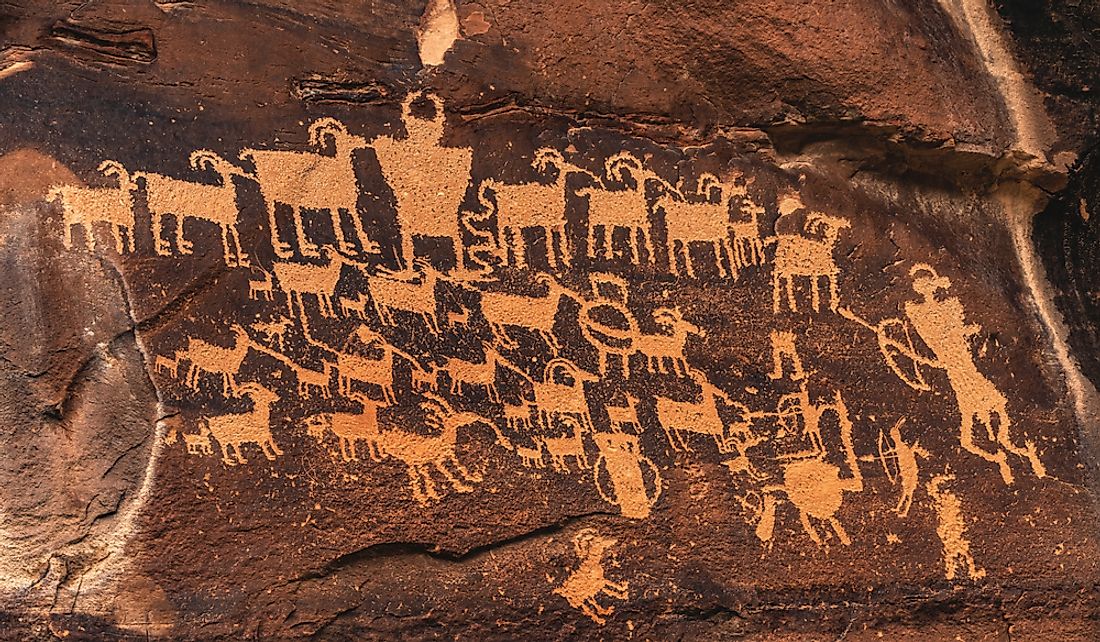What Is A Petroglyph?

Petroglyphs are images carved on the surface of a rock. The techniques used to create these images include pecking, incising, abrading, sculpting, polishing, drilling, and scratching. These processes remove part of the rock and therefore are different than images simply painted on drawn on rock which are called petrographs. Petroglyphs are typically associated with prehistoric populations and can be found throughout the world. However, Africa, Siberia, Scandinavia, Australia, and southwestern North America have the highest concentration of petroglyphs.
Brief History of Petroglyphs
Rock art was an ancient method used to record both real and abstract events, stories, ideas, and feelings. Petroglyphs were part of this ancient art, which can be traced back more than 10,000 years, and became common during the Neolithic and late Upper Paleolithic periods. The word petroglyph is derived from two Greek words, petros meaning "stone," and glyphein meaning "to carve." Petroglyphs took two primary forms, as images either appear as scratches or deeper visible indentations on rock. Thousands of years later, many petroglyphs remain well preserved.
Significance of Petroglyphs
Petroglyphs were used for various purposes. They are among the earliest forms of art to have existed and are therefore considered the foundation of art. Ancient peoples also used petroglyphs as a form of communication or writing. For example, some petroglyphs clearly indicated the borders between tribal lands, and others were astronomical markers and maps. Additionally, some petroglyphs served as musical instruments and were known as "rock gongs."
Petroglyph Sites Around the World
Petroglyph sites exist in every continent throughout the world, except Antarctica.
Notable petroglyph sites in Africa include Tassili n’Ajjer. Located in Algeria, the site contains images of cattle and large wild animals carved on rock. In Liberia, Akakus is a petroglyph site that was declared a UNESCO World Heritage Site in 1985. Its images date back to 12,000 BCE and feature ostriches, horses, giraffes, people, and elephants. Wadi Hammamat is a notable petroglyph site near Qift, Egypt.
In Australia, petroglyph sites include Murujuga in Western Australia, the Sydney Rock Engravings in New South Wales, and Kakuda National Park in the Northern Territory. Murujuga is the largest petroglyph site in the world and is believed to have existed since the Ice Age.
Wadi Rum in Jordan and the Graffiti Rocks near Riyadh, Saudi Arabia, are well-known petroglyph sites in the Middle East.
Examples of Asia’s petroglyph sites include the Edakkal Caves in Wayanad, India, the Bangudae Petroglyphs in Ulsan, South Korea, as well as Tung Lung Island, Po Toi Island, Wong Chuk Hang, and Cheung Chan in Hong Kong.
In Europe, petroglyph sites exist in France's Mercanton National Park, Newgrange in Ireland, Kamyana Mohyla in Ukraine, and Northumberland in England. A unique feature of the petroglyphs in Northumberland is that they are cup and ring marked.
Petroglyph sites in South America include Cumbe Mayo in Peru and Corantijn Basin in Suriname.
North America has the highest number of petroglyphs in the world. Sites include Death Valley National Park and Northern Mojave in the US state of California, and Capitol Reef National Park in the US state of Utah.











